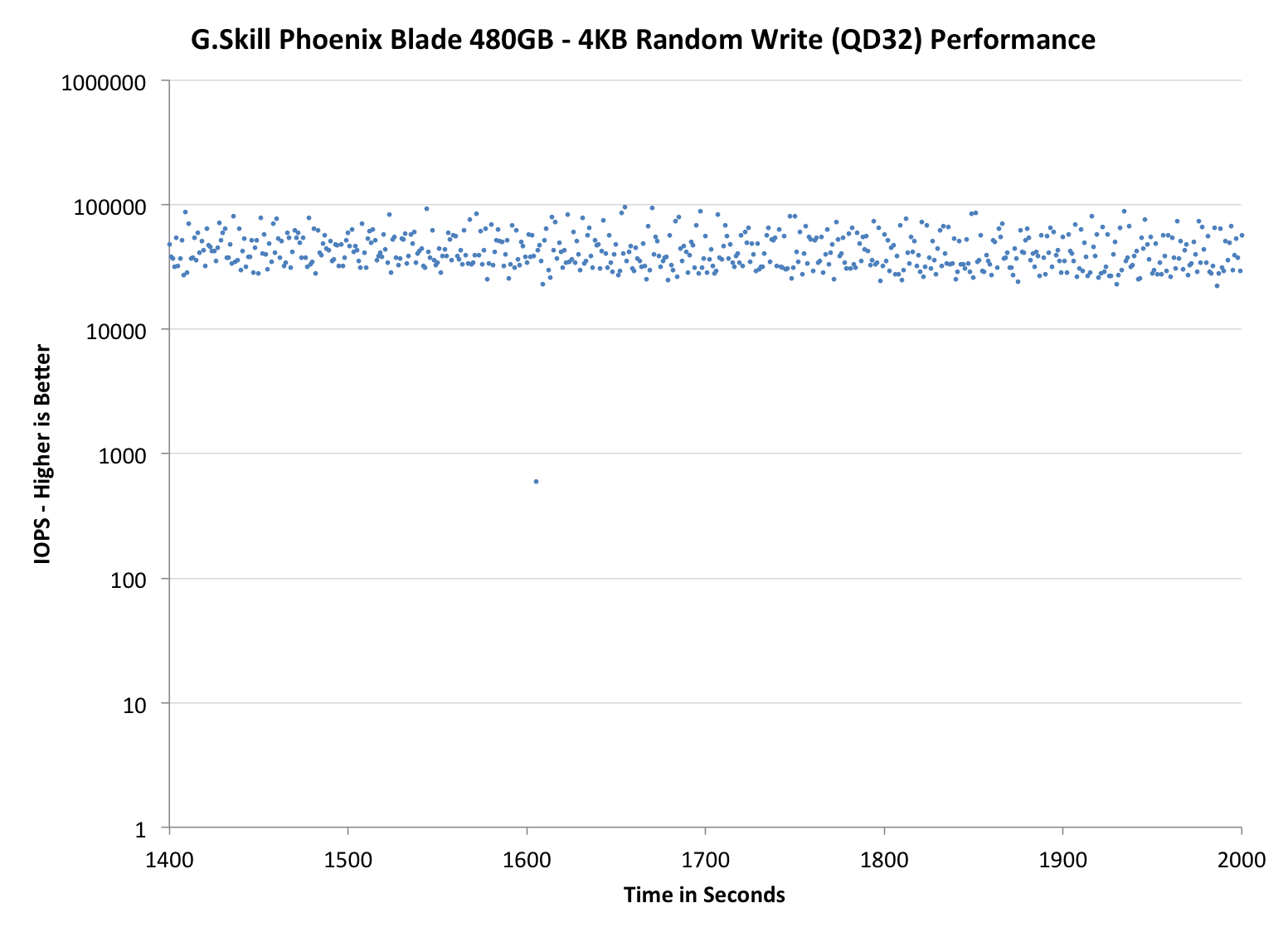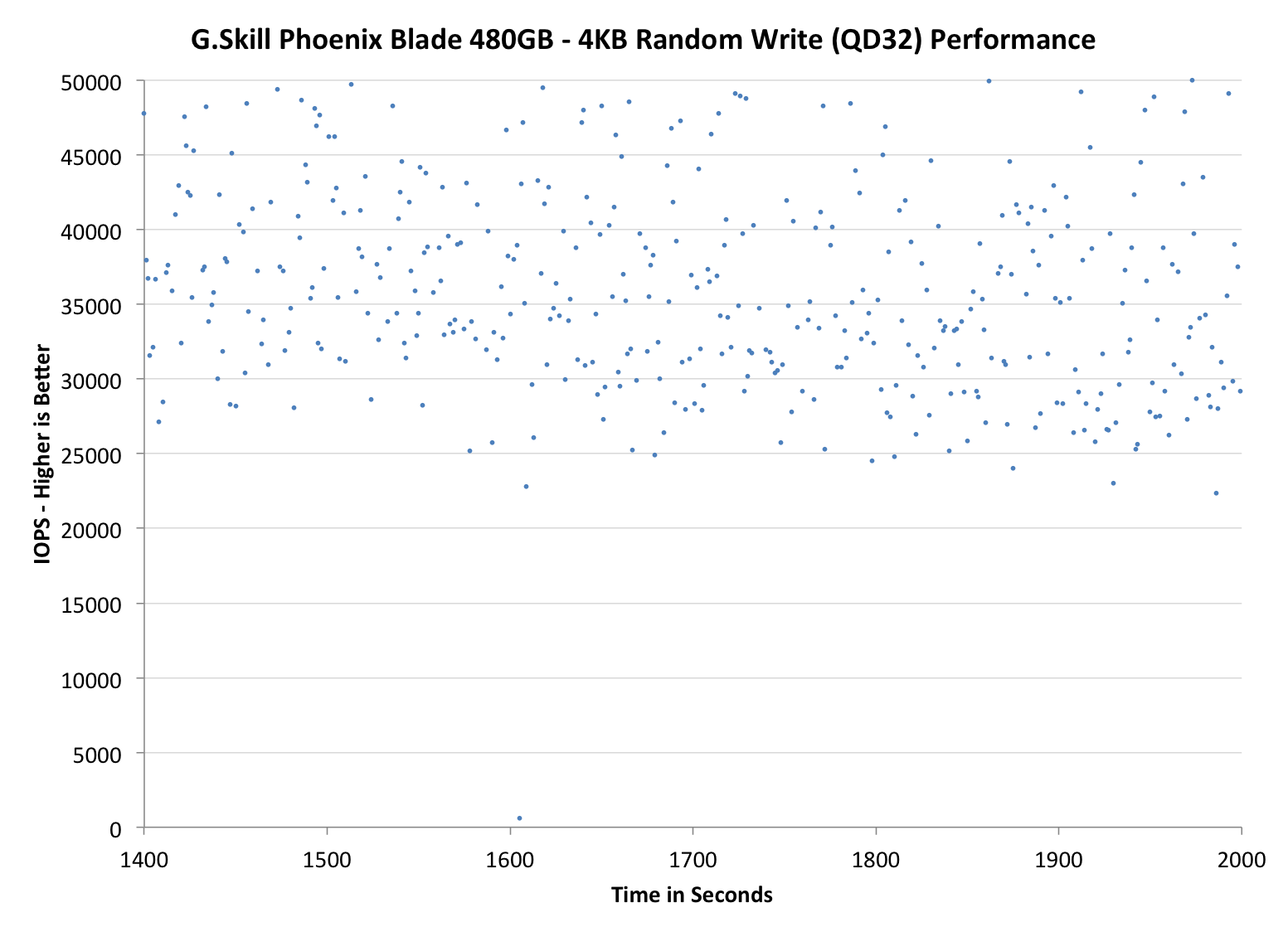G.Skill Phoenix Blade (480GB) PCIe SSD Review
by Kristian Vättö on December 12, 2014 9:02 AM ESTPerformance Consistency
Performance consistency tells us a lot about the architecture of these SSDs and how they handle internal defragmentation. The reason we do not have consistent IO latency with SSDs is because inevitably all controllers have to do some amount of defragmentation or garbage collection in order to continue operating at high speeds. When and how an SSD decides to run its defrag or cleanup routines directly impacts the user experience as inconsistent performance results in application slowdowns.
To test IO consistency, we fill a secure erased SSD with sequential data to ensure that all user accessible LBAs have data associated with them. Next we kick off a 4KB random write workload across all LBAs at a queue depth of 32 using incompressible data. The test is run for just over half an hour and we record instantaneous IOPS every second.
We are also testing drives with added over-provisioning by limiting the LBA range. This gives us a look into the drive’s behavior with varying levels of empty space, which is frankly a more realistic approach for client workloads.
Each of the three graphs has its own purpose. The first one is of the whole duration of the test in log scale. The second and third one zoom into the beginning of steady-state operation (t=1400s) but on different scales: the second one uses log scale for easy comparison whereas the third one uses linear scale for better visualization of differences between drives. Click the dropdown selections below each graph to switch the source data.
For more detailed description of the test and why performance consistency matters, read our original Intel SSD DC S3700 article.
 |
|||||||||
| Default | |||||||||
| 25% Over-Provisioning | |||||||||
Even though the Phoenix Blade and RevoDrive 350 share the same core controller technology, their steady-state behaviors are quite different. The Phoenix Blade provides quite substantially higher peak IOPS (~150K) and it is also more consistent in steady-state as the RevoDrive frequently drops below 20K IOPS while the Phoenix Blade doesn't.
 |
|||||||||
| Default | |||||||||
| 25% Over-Provisioning | |||||||||
 |
|||||||||
| Default | |||||||||
| 25% Over-Provisioning | |||||||||
TRIM Validation
To test TRIM, I turned to our regular TRIM test suite for SandForce drives. First I filled the drive with incompressible sequential data, which was followed by 60 minutes of incompressible 4KB random writes (QD32). To measure performance before and after TRIM, I ran a one-minute incompressible 128KB sequential write pass.
| Iometer Incompressible 128KB Sequential Write | |||
| Clean | Dirty | After TRIM | |
| G.Skill Phoenix Blade 480GB | 704.8MB/s | 124.9MB/s | 231.5MB/s |
The good news here is that the drive receives the TRIM command, but unfortunately it doesn't fully restore performance, although that is a known problem with SandForce drives. What's notable is that the first LBAs after the TRIM command were fast (+600MB/s), so in due time the performance across all LBAs should recover at least to a certain point.










62 Comments
View All Comments
otherwise - Monday, December 15, 2014 - link
For those interested, here is the P3xxx series page at intel, which used to contain all three models, but now just the P3600 and P3700: http://www.intel.com/content/www/us/en/solid-state...otherwise - Monday, December 15, 2014 - link
Fixed link: http://www.intel.com/content/www/us/en/solid-state...r3loaded - Friday, December 12, 2014 - link
Is anyone ever going to get around to producing a native PCIe drive that's actually available at retail for enthusiasts to buy for their systems? Bonus points if it supports NVMe. The SSD in my MacBook Pro is faster than the one in my desktop PC and that just doesn't sit right with me.biostud - Friday, December 12, 2014 - link
Can't it boot from a X99 setup?FunBunny2 - Friday, December 12, 2014 - link
The text says 2281, but the table 2282?? Typo? Matter much?Antronman - Friday, December 12, 2014 - link
For just $300 more, I'll take an iO-FX any day over this PCIe SSD.Poik - Friday, December 12, 2014 - link
Only price I see for an iO-FX is $1380 from Amazon. That's pretty much $700 more or double the price. Even so for an extra $300 I'd rather have 2 XP941's.Antronman - Friday, December 12, 2014 - link
I was comparing Amazon costs, as I found the Phoenix Blade 480GB for $1000 on Amazon. But after checking Newegg, it is only $680 on Newegg. Oh well. The iO-FX is still worth it. The speed and reliability is simply second to none. While it might be a little bit overkill for the average consumer, I don't believe PCIe SSDs (especially ones this expensive) are for the average consumer. If you're buying a single storage drive that costs $680, you can buy a storage drive that costs $1400.bill.rookard - Friday, December 12, 2014 - link
Interesting piece of hardware, but I'm interested in it more for my used servers. I have several running and something with that kind of durability rating and the all important backwards compatibility and form factor would allow me to have all kinds of fun with that on my Xeon box.Of course, two of them would set me back $1500.00 - details, details.
Supercell99 - Saturday, December 13, 2014 - link
My guess is for a server environment, something that has to be 24/7, a product this new should be tested for a while before I would put it into a production machine, just to see what happens :)